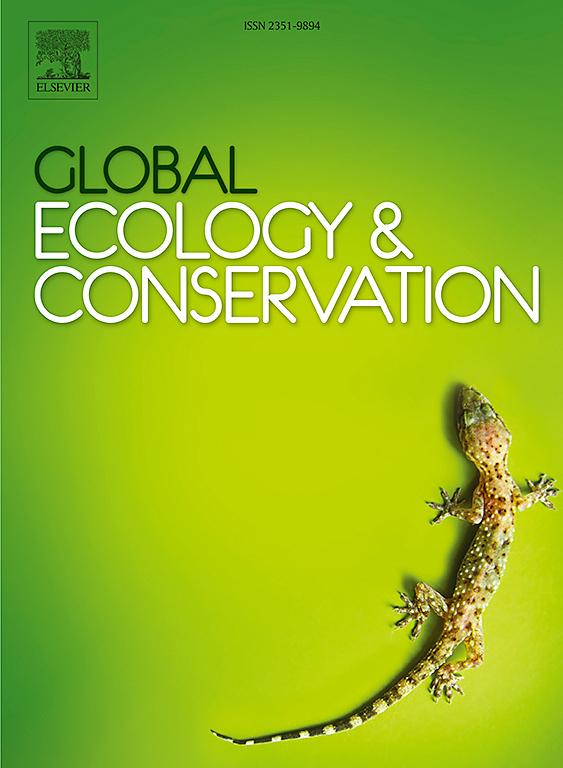多元化首先!充实表型多样性的尾部,增强人类世的适应能力
IF 3.4
2区 环境科学与生态学
Q1 BIODIVERSITY CONSERVATION
引用次数: 0
摘要
目前环境变化的速度超过了大多数生物在过去几百万年里所经历的,预计在人类世会有更多的极端变化和事件。新兴环境将包括非生物和生物条件的新组合,迫使种群和物种要么适应,要么迁移,以避免灭绝。内源性突变率是缓慢的,特别是当自然种群下降和分裂时。表型可塑性有其局限性,特别是在生理耐受的极端情况下。只有当适宜的栖息地在迁徙能力范围内时,迁徙才是有效的。渐渗杂交是自然多样化的重要组成部分,是产生新的健壮表型的有效手段。通过部分杂交物种间的渐进杂交来促进表型多样化可能是一种有效的保护策略,使濒危物种能够适应和应对。这些物种组合作为地理和分类学上的网络合体,允许优势性状的交换,补充遗传多样性,恢复失去的生态和生理功能。物种内的表型异常值-具有罕见但有益特征的个体-对于维持这些网络中的适应潜力非常重要。幸运的是,由于种间遗传交换的自然水平,物种通常保持其凝聚力身份。实验计划和理论研究对于探索在定义的合成子内加速渐进杂交的影响至关重要,其目标是解决不确定性和改进方法。随着环境变化的加速,通过杂交促进表型多样化提供了保持适应能力的主动策略。这种方法有可能通过即将到来的生物多样性瓶颈来保护生物多样性和生态系统功能。本文章由计算机程序翻译,如有差异,请以英文原文为准。
Diversify first! Fatten the tails of phenotypic diversity to enhance adaptive capacity in the Anthropocene
The current pace of environmental change exceeds what most organisms have experienced over the past few million years, with more extreme shifts and events anticipated in the Anthropocene. Emerging environments will include novel combinations of abiotic and biotic conditions, forcing populations and species to either adapt or migrate to avoid extinction. Endogenous mutation rates are slow, particularly as natural populations decline and fragment. Phenotypic plasticity has its limits, particularly at extremes of physiological tolerance. Migration is only effective if appropriate habitat exists within dispersal abilities. Introgressive hybridization, an important element of natural diversification, has been effective means to generate novel vigorous phenotypes. Assisting phenotypic diversification through introgressive hybridization among suites of partially interfertile species could be an effective conservation strategy to enable endangered species to adapt and respond. These suites of species function as a geographically and taxonomically networked syngameon, allowing exchange of advantageous traits, replenishing genetic diversity, and restoring lost ecological and physiological functions. Phenotypic outliers within species - individuals with rare but beneficial traits - are important for maintaining adaptive potential within these networks. Fortunately, species typically maintain their cohesive identities given natural levels of interspecific genetic exchange. Experimental programs and theoretical studies will be essential to explore the impacts of accelerated introgressive hybridization within defined syngameons, with the goals of addressing uncertainties and refining methods. As environmental changes accelerate, promoting phenotypic diversification through hybridization offers a proactive strategy to maintain adaptive capacity. This approach has the potential to safeguard biodiversity and ecosystem functionality through the upcoming biodiversity bottleneck.
求助全文
通过发布文献求助,成功后即可免费获取论文全文。
去求助
来源期刊

Global Ecology and Conservation
Agricultural and Biological Sciences-Ecology, Evolution, Behavior and Systematics
CiteScore
8.10
自引率
5.00%
发文量
346
审稿时长
83 days
期刊介绍:
Global Ecology and Conservation is a peer-reviewed, open-access journal covering all sub-disciplines of ecological and conservation science: from theory to practice, from molecules to ecosystems, from regional to global. The fields covered include: organismal, population, community, and ecosystem ecology; physiological, evolutionary, and behavioral ecology; and conservation science.
 求助内容:
求助内容: 应助结果提醒方式:
应助结果提醒方式:


